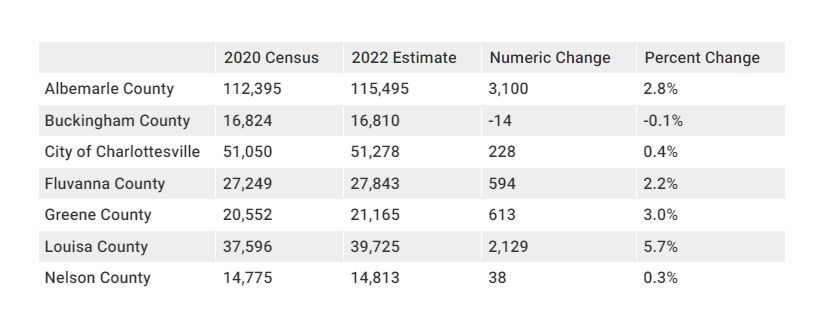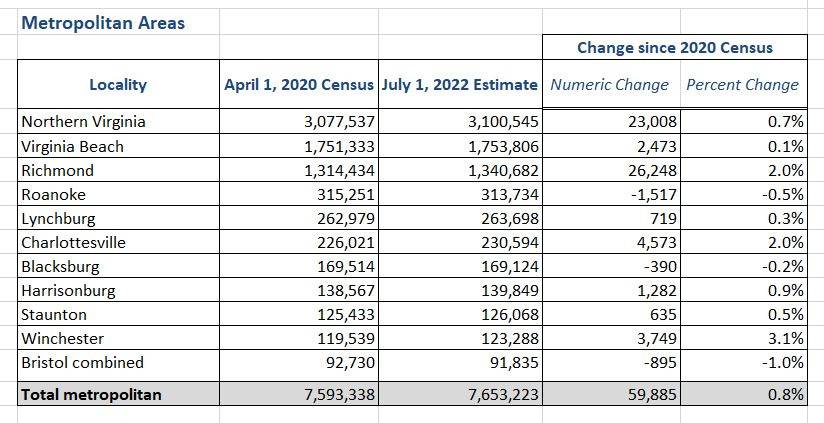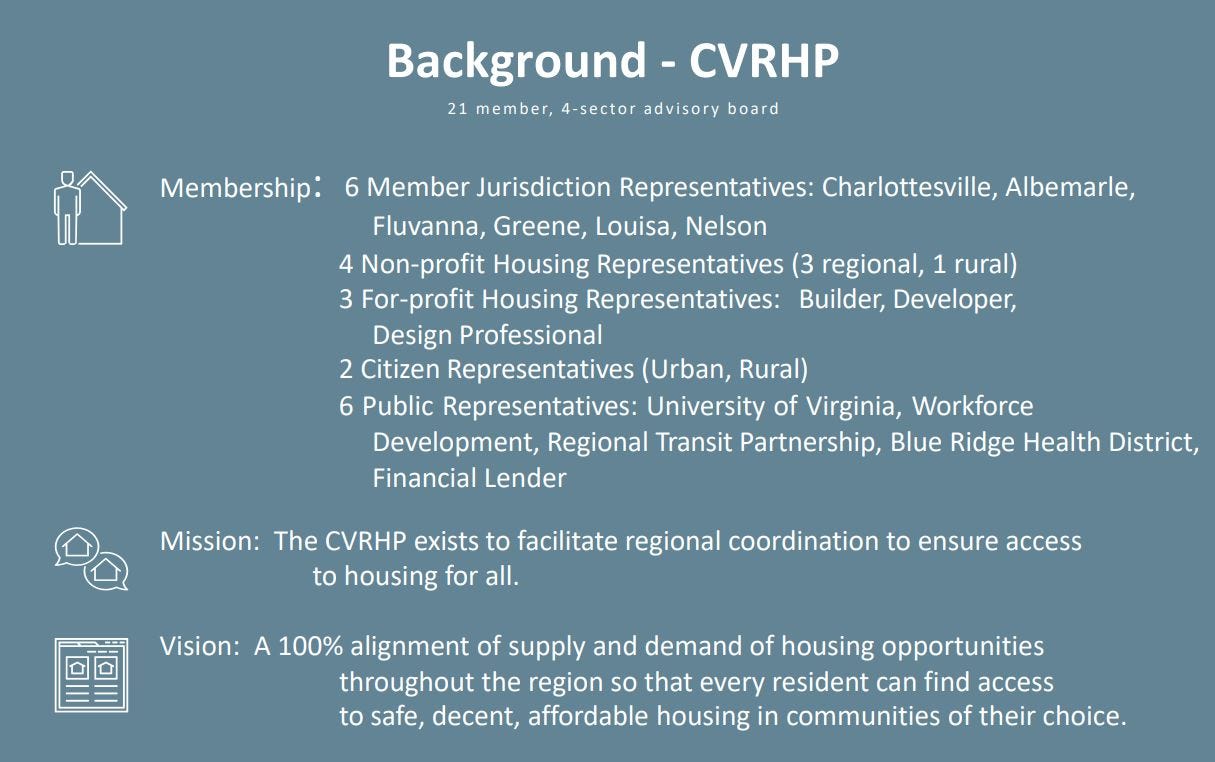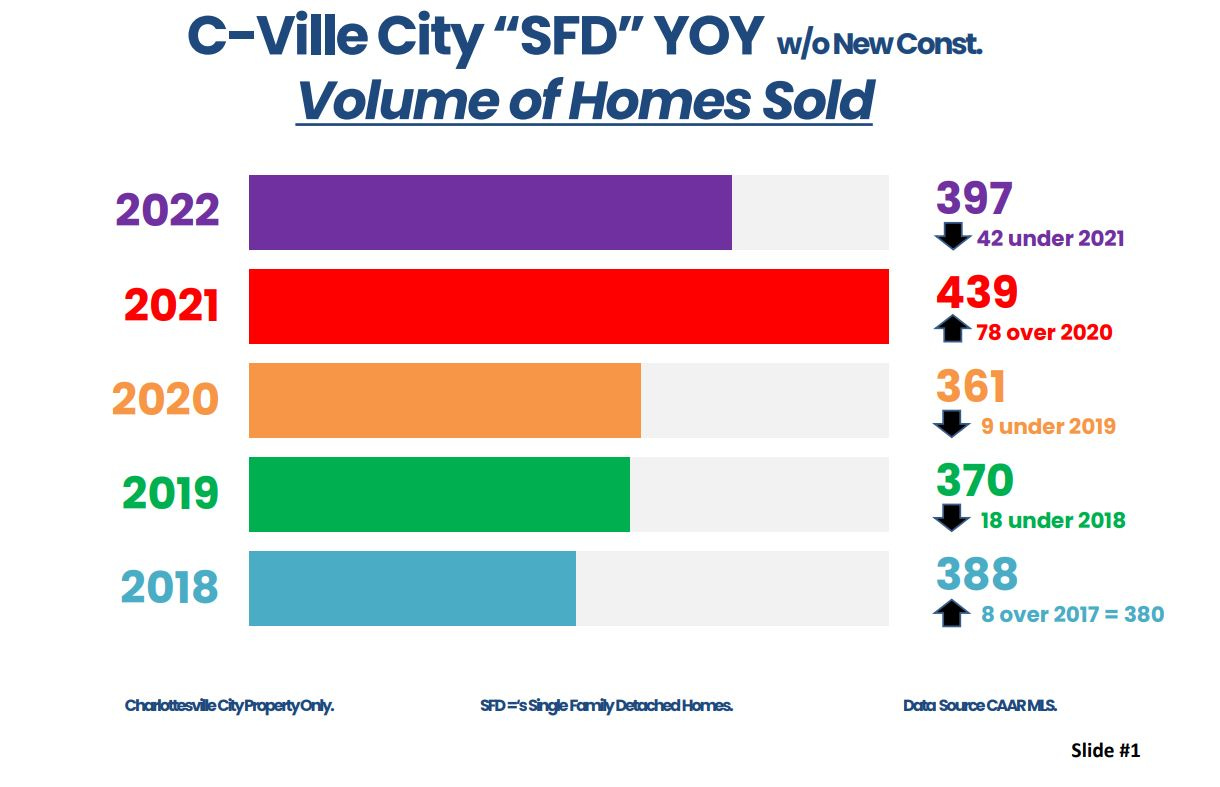!yad drawkcaB lanoitaN ot emocleW! Though it is possible that this day may be a figment of my imagination.
This is also the final day of January, a month I feel I only just got to know. At the end of midnight, 2023 will have passed the 8.5 percent mark. There’s so much to keep track of, both imaginary and real, and both my fictional and non-fictional selves occasionally team up for a little something we both call Charlottesville Community Engagement. I’m Sean Tubbs, or at least, one of me is.
On today’s program:
A dozen more people have filed to be considered as a replacement City Councilor, bringing the total to 20
All localities in the Thomas Jefferson Planning District experienced population growth since the U.S. Census, with Louisa County growing the most
The Central Virginia Regional Housing Partnership introduces itself to the current City Council
Today’s first shout-out: LEAP wants to help you prepare for winter
Crisp air. Hot cocoa. The possibility of snow days. There are plenty of reasons to be excited about winter, but the return of high heating bills is not one of them. Your local energy nonprofit, LEAP, has been empowering Virginians with energy efficiency and solar solutions since 2010. With programs for all income levels, residents can access upgrades like insulation, LED bulbs, low-flow fixtures, and affordable rooftop solar systems. Visit www.leap-va.org to learn more, and fill out the LEAP Services Inquiry form to lower high heating bills and stay cozy this winter.
Twenty people have filed to be appointed City Councilor in Charlottesville
The four remaining members of Charlottesville City Council now have 20 choices before them for a person to be appointed as the fifth. They include a sitting Planning Commissioner, a sitting School Board member, two former City Councilors, two former School Board members and a variety of others who want to join Council as it considers the next city budget and the next set of rules for how new structures can be built.
Here’s a little about each of the twelve candidates who have filed since January 24. Do read the full applications for details. Here’s a list of the other eight.
Kate Bennis has lived in Charlottesville for 16 years and identifies herself as a “clinical social worker, a communication coach and trainer, and an active civic participant.” She served as the president of the Little High Neighborhood Association from 2017 to 2019. (read application)
Michael Cusano has lived in Charlottesville for three years and three months. He is the president of the Johnson Village Neighborhood Association and has served on the Housing Advisory Committee. Cusano is a reconstruction project manager who has served over ten years in emergency medical services. (read application)
Philip d’Oronzio has lived in Charlottesville for over 20 years. He is the CEO of Pilot Mortgage and was appointed to the Planning Commission this past September after having served on the Housing Advisory Committee from 2014 to its reconstitution earlier this year. That included five years as its chair. (read application)
Kathy Galvin has lived in Charlottesville for forty years and spent eight of them on City Council and another four on the School Board. She is an architect who currently works for the Renaissance Planning Group. Like fellow former City Councilor Kristin Szakos, Galvin has indicated she will not seek election to a full third term.(read application)
Margaret Gardiner has lived in Charlottesville for 28 years and is a resident of Fry’s Spring. She has worked in higher education for 27 years. (read application)
Sam Gulland has lived in Charlottesville for three years. He has served as an Infantry Officer in the U.S. Army for six years and has spent the last seven years on developing utility-scale solar facilities. Gulland has indicated he will not seek election in the fall. (read application)
Carla Manno has lived in Charlottesville for 30 years and was vice president of the Fifeville Neighborhood Association when she was 22. She’s worked as a teacher and included a letter she wrote to C-Ville Weekly in 1994 as part of her application. (read application)
Sarah Moniz has lived in Charlottesville for a year and a half and is currently the human resources manager for The Haven. She’s also worked for the Blue Ridge Area Coalition for the Homeless as an administrative coordinator. (read application)
Natalie Oschrin has lived in Charlottesville for 28 years and said experience living here is a “valuable resource.” She’s a graduate of the University of Virginia and has a Master’s degree in Hospitality and Tourism Management from the University of South Carolina. (read application)
Rosia Parker has lived in Charlottesville for 28 years and has served on both the Charlottesville Redevelopment and Housing Authority’s Board of Commissioners as well as the Police Civilian Review Board. In her application, Parker said she doesn’t have the financial resources to run for Council and this is her only way to become a Councilor. (read application)
Maynard Sipe has lived in Charlottesville for over 40 years. He’s a land use attorney who has lived in the Fifeville neighborhood for 23 years. Sipe said his experience in municipal law would help the city with the zoning rewrite. He indicated he will not run for a full term. (read application)
Lisa Torres has lived in Charlottesville for 23 years and is in her second term on the School Board. She works as a physical home therapist. Torres said her experience as an elected official would be valuable to the city at this time. (read application)
What happens next? City Council Clerk Kyna Thomas has sent this information to each of the candidates:
A Public Hearing will be conducted at the February 6 City Council meeting. Council will give candidates 3-5 minutes (TBD) to speak first before opening the floor to others. If you have not registered for the meeting already you will need to register for a seat in Council Chamber OR for the Zoom link in order to participate.
Councilors will likely discuss applicants during closed sessions on February 6 and 21 and make a decision on February 21 to be within the 45 day deadline before a judge would appoint someone.
Consideration is also being given to interviewing select candidates separately. We’ll communicate as more information is known.
Weldon Cooper Center estimates show regional growth of 2.5 percent since 2020 Census
The population of the six localities that make up the Thomas Jefferson Planning District Commission grew by 2.5 percent between the 2020 U.S. Census and the beginning of the fiscal year.
That’s according to the latest population estimates from the Weldon Cooper Center at the University of Virginia. These are used by the Commonwealth of Virginia for all manner of planning purposes.
“Population estimates are an important tool used by a variety of state agencies in their planning processes — from developing budgets to determining salaries for public officials,” reads an overview of the website for the data that was made available yesterday.

The entire TJPDC region is estimated to have a population of 270,139, up from 263,617 in the U.S. 2020 Census.
Albemarle County is estimated to have added 3,100 people in two years and three months for a total of 115,495 people. That’s an increase of 2.8 percent since the 2020 Census.
Louisa County had a 5.7 percent increase for a total of 39,725 people on July 1, 2022. The 2020 Census counted 37,596 people.
Greene County’s estimate is 21,165, an increase of 613 people. That’s a 3 percent increase.
Fluvanna County added 594 people over the period to an estimated population of 27,843. That’s a 2.2 percent increase.
Charlottesville has the second smallest increase of the six localities with 0.4 percent with a 2022 estimate of 51,278. That’s 228 more people. The numbers for Charlottesville deserve a little explanation.
“Across the country, localities with relatively large college populations, including some Virginia localities, were often undercounted in the April 1st, 2020 Census Count,” reads the website for the population estimates.
The U.S. Census counted 46,553 people in Charlottesville on April 1, 2020. That was after the University of Virginia canceled in-person classes for the rest of the spring semester due to the COVID pandemic.
Weldon Cooper instead is using their own 2020 population estimates as a benchmark for Charlottesville, as well as Harrisonburg, Lexington, Lynchburg, Montgomery County, Prince Edward County, Radford, and Williamsburg.
“Once the remainder of the 2020 Census data is released later this year, we will further examine the discrepancies in college town populations and make additional adjustments if needed,” the website continues.
Nelson County rounds out the TJPDC region with a 38 person increase over two years with a population of 14,813. That’s a 0.3 percent increase, the lowest in the region.
Regional conversations about population should also take Buckingham County into consideration given its proximity to Scottsville as well as its inclusion in the federally-defined Metropolitan Statistical Area. Buckingham takes Louisa’s place for these purposes.
Buckingham County has an estimated population with 14 fewer people than on April 1, 2020. The total estimate is 16,810.
The Charlottesville MSA increased by two percent to a population of 230,594. That makes it the 6th largest metro area in Virginia, in between Lynchburg at 5th and Blacksburg at 7th.

Second shout-out: Bake-N-Bike with Charlottesville Community Bikes
In today’s second subscriber supporter shout-out, Charlottesville Community Bikes wants you to join them for their annual Valentine’s Day Fundraiser, Bake-N-Bike!
On Tuesday, February 14, costumed bike couriers will deliver pre-ordered bags of scones all around Charlottesville. Bags will include 6 scones (chocolate chip and cranberry) baked and packaged by Sweet Holly's Desserts, and you can add a personalized note for the recipient.
Deliveries will be made from 11 am to 3 pm. If you live outside of our delivery area, you can also pre-order scones and pick them up at Community Bikes on Tuesday, February 14. They are limited to 160 bags of scones, so order as soon as you can! Visit charlottesvillecommunitybikes.org to learn more!
Regional Housing Partnership officials appear before Charlottesville City Council
It has been a year and a half or so since the Thomas Jefferson Planning District Commission adopted a document called Planning for Affordability that sought to help all six regions in the community update the housing chapter of their respective Comprehensive Plan.
The work is part of something called the Central Virginia Regional Housing Partnership, a subset of the TJPDC. This month, members of the partnership have been appearing before different elected bodies to share what the group does. Albemarle County’s turn is this Wednesday, but Charlottesville City Council saw the presentation on January 17. (view the presentation)
“The ‘why’ behind the partnership was created is that we all know we have housing affordability issues and its not just specific to any one jurisdiction that’s in the Commission,” said Ned Gallaway, the Rio District representative on the Albemarle Board of Supervisors. “It is a regional issue and while regional solutions may vary depending on if you are urban or rural, perhaps our solutions with our boundaries, but the information sharing, the data collection, and the efforts should be shared to help us all solve the problem.”
Partnership meetings are intended to be places to discuss issues such as length of time it takes to get a building permit. That came up at the meeting in December, for instance.
Gallaway said that each locality still controls its own policies, but the partnership serves as a way for staff in each to be able to get resources.
“Think of the Regional Housing Partnership as a living tool box if you will,” Gallaway said. “If you need a place to bounce ideas off of or to discuss or to pull data from, that’s what you would come to the partnership for.”
A major force behind the creation of the partnership is Keith Smith, a Realtor and Fluvanna County representative on the TJPDC.
“I’m a private sector person,” Smith said. “It was part of the thought process in helping put this together [that] I was finding that the public sector, the nonprofit sector, and the private sector just really weren’t communicating well. They were speaking the same thing but in different languages.”
Smith shared recent housing data that indicates that the number of units available for sale is going up but the price of each is also going up.
“The units are all over the map but the prices are climbing up,” Smith said.
In Charlottesville, the median sales prices for existing single family detached homes increased from $349,000 in 2018 to $475,000 in 2022. Existing townhomes, duplexes, and other single-family attached homes increased from a median sales price of $250,000 in 2018 to $328,000 in 2022.
“Most know that I also chair the [Piedmont Community Land Trust] and I know a little about what the sales prices need to be to hit the 80 percent to 60 percent [area median income],” Smith said. “And the sales price to do that needs to be at preferably below $200K but you can probably squeak it up in today’s interest rates to about $215K. Once you start going over that, you can’t fit within the 60 to 80 percent AMI.”
Smith said the partnership also has a data committee that seeks to help get more information out to community members. Another idea for the partnership is to create a regional land bank for affordable housing projects. The partnership is pursuing a grant for a feasibility study at this time.
City Councilor Brian Pinkston wanted to know if the partnership has access to the skills of an economist to model scenarios.
“What would it look like to have adequate supply?” Pinkston asked. “Theoretically I guess as supply goes up, costs go down but in Charlottesville it feels like no matter what you do, because of the draw of the University and because of the fact that it’s such a great place to live, it’s not fungible.”
In other words, a ten percent increase in supply would not necessarily increase a corresponding decrease in price.
Gallaway said the partnership still has limited funds and currently could not afford to hire an economist, but could apply for grants to do so. Smith said the data committee would look into the idea as well.
Councilor Michael Payne said continued subsidies are the only solution for the many people in Charlottesville who are below 60 percent of AMI.
“At this point we’re almost kidding ourselves if we think the supply side solutions are going to be enough to ever meet the biggest need in our community and we have to invest in subsidies and community land trusts, and a land bank because it’s just not going to be enough otherwise,” Payne said.
The Affordable Housing Plan adopted by Council in March 2021 morally commits the elected body to spending at least $10 million a year on housing. For more details on that, visit Information Charlottesville for a collection of previous segments on housing from Charlottesville Community Engagement.
What do you want to know about the market? I now write a weekly column for C-Ville Weekly and I’m looking for ideas and questions to track down. It’s one area that so many don’t understand, and perhaps together we can figure more of it out.
Reading material:
Bellamy Brown resigns from police oversight board, makes bid for state House seat, Alice Berry, Charlottesville Daily Progress, January 28, 2023
Charlottesville residential, commercial property values up, January 28, 2023, Charlottesville Daily Progress
Former Charlottesville mayor Dave Norris announces campaign for Va. 54th District seat, Elizabeth Rambo, Cavalier Daily, January 29, 2023
Filmed brawl at Charlottesville High prompts calls for action, Charlottesville Daily Progress, January 29, 2023
This week in city government with Sean Tubbs, WINA’s Charlottesville Right Now with Courteney Stuart, January 30, 2023
Keeping things honest in the end notes for #491
I write a lot, and every now and then I print something that is incorrect. And now I have many different places where I am posting material. The standard policy is roughly the same. I make a correction or clarification in the text, mark that an error occured, and then leave a comment saying what I did.
One of the original reasons for this end section was to also make note of the errors, but as a one-person operation, I often neglect to write out the mistakes. This is mostly a factor of wanting every day to get to the new set of stories.
But, for now, let me say a few things.
I posted an incorrect age for someone shot by gunfire
On April 22, 2022 I put the wrong date for the foundation of the Crossroads Tavern in North Garden
I said yesterday that crime data published by the City of Charlottesville had not been updated since November 2022. For whatever reason, it’s now updated, and the crime map is live once more.
The eviction diversion program mentioned yesterday has helped over 116 households last year with resources. That’s a tidbit from the same meeting you heard from earlier.
All of this work is in flux as the lives we are all living continue to ebb and flow. I’m not perfect, but I have aspirations for accuracy. Thank you to everyone who is helping support me as I try to track as much of the tide as possible.
Now, a haiku:
Substack payments rock!
They do keep me in business
Ting matches first payment I’d try an iambic pentameter for the rest of the shout-out to Ting, but I lost my rhyming dictionary. Want to upgrade your internet so you can download things faster?
If you sign up at this link and enter the promo code COMMUNITY, you’ll get:
Free installation
A second month for free
A $75 gift card to the Downtown Mall
Thanks to Wraki for the music. There is going to be a new closing tune beginning with #500 and hopefully other audio cues here and there, too. Do give the podcast a chance if you’ve not heard it to this point. Today there is a weird secret clue to a podcast that is 100 percent fictional but that gum you like may be coming back in style.
















Share this post